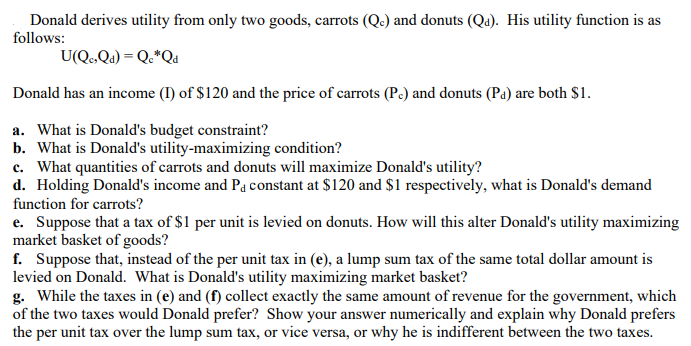Donald derives utility from only two goods, carrots (Q.) and donuts (Qa). His utility function is as follows: U(Q..Qa) = Q.*Q« Donald has an income (1) of $120 and the price of carrots (P.) and donuts (Pa) are both $1. a. What is Donald's budget constraint? b. What is Donald's utility-maximizing condition? c. What quantities of carrots and donuts will maximize Donald's utility?
Donald derives utility from only two goods, carrots (Q.) and donuts (Qa). His utility function is as follows: U(Q..Qa) = Q.*Q« Donald has an income (1) of $120 and the price of carrots (P.) and donuts (Pa) are both $1. a. What is Donald's budget constraint? b. What is Donald's utility-maximizing condition? c. What quantities of carrots and donuts will maximize Donald's utility?
Micro Economics For Today
10th Edition
ISBN:9781337613064
Author:Tucker, Irvin B.
Publisher:Tucker, Irvin B.
Chapter6: Consumer Choice Theory
Section6.A: Indifference Curve Analysis
Problem 3SQP
Related questions
Question
Explain why two indifference

Transcribed Image Text:Donald derives utility from only two goods, carrots (Qe) and donuts (Qa). His utility function is as
follows:
U(Q,Qa) = Q•*Qa
Donald has an income (I) of $120 and the price of carrots (Pc) and donuts (Pa) are both $1.
a. What is Donald's budget constraint?
b. What is Donald's utility-maximizing condition?
c. What quantities of carrots and donuts will maximize Donald's utility?
d. Holding Donald's income and Pa constant at $120 and $1 respectively, what is Donald's demand
function for carrots?
e. Suppose that a tax of $1 per unit is levied on donuts. How will this alter Donald's utility maximizing
market basket of goods?
f. Suppose that, instead of the per unit tax in (e), a lump sum tax of the same total dollar amount is
levied on Donald. What is Donald's utility maximizing market basket?
g. While the taxes in (e) and (f) collect exactly the same amount of revenue for the government, which
of the two taxes would Donald prefer? Show your answer numerically and explain why Donald prefers
the per unit tax over the lump sum tax, or vice versa, or why he is indifferent between the two taxes.
Expert Solution
This question has been solved!
Explore an expertly crafted, step-by-step solution for a thorough understanding of key concepts.
Step by step
Solved in 2 steps

Recommended textbooks for you







Exploring Economics
Economics
ISBN:
9781544336329
Author:
Robert L. Sexton
Publisher:
SAGE Publications, Inc


Economics (MindTap Course List)
Economics
ISBN:
9781337617383
Author:
Roger A. Arnold
Publisher:
Cengage Learning